This is the first of seven articles about the important part Shoreham plays in aviation history, written by local expert Andy Ramus.
Prologue- The Aeronauts’ Balloon Years.
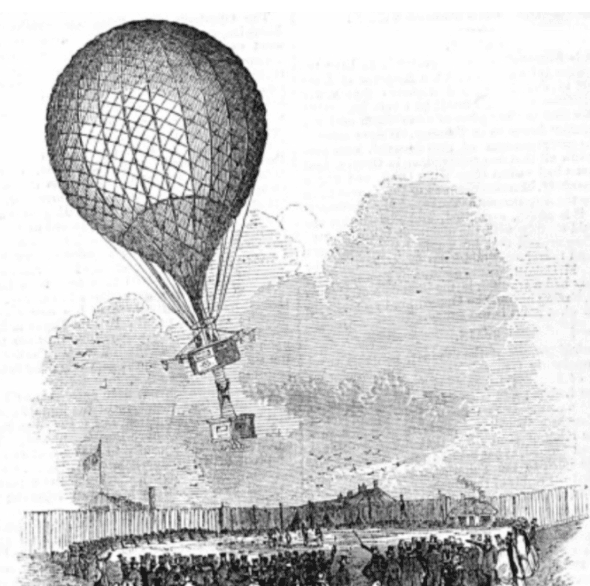
Any aviation history of Shoreham should hardly ignore the first attempts at flight by ‘lighter than air’ machines, otherwise known as hot air balloons. Quite by accident, while researching the history of ‘heavier than air’ machines, I came across old news articles which told the story of intrepid Aeronauts from a much earlier era, beginning with a cross channel flight no less. After digging a little deeper, I found these fascinating stories which take our aviation history back another 60 years to 1850, with a certain George Burcher Gale, and various flights in between. The Swiss Gardens, where the Swiss Cottage pub now stands, were the starting point for these adventures, advertised as part of the entertainments bill provided by the hosts.
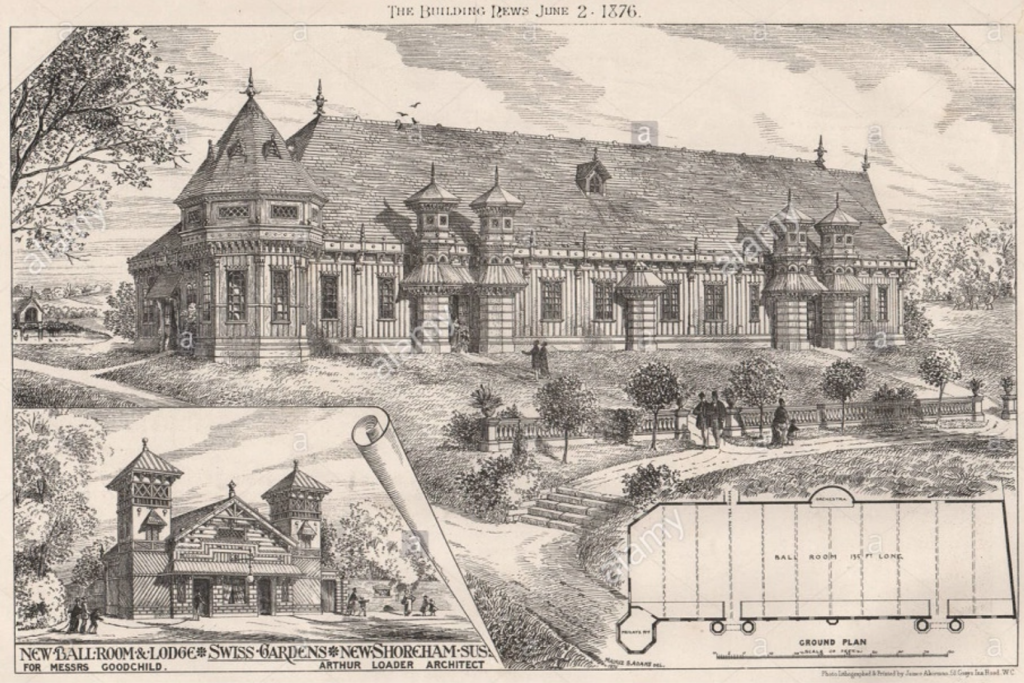
Below are the articles from the time:-
Swiss Gardens, Shoreham, to Dieppe. Cross channel balloon trip, Monday 8th July 1850
News report from the:-
Brighton Gazette- Thursday 11 July 1850
‘A vast concourse of persons were attracted to the Swiss gardens on Monday evening by an announcement that Lieutenant Gale, R.N., would ascend in his balloon from the Gardens. The balloon, which was inflated with gas at the Hove Gas Works early on Monday morning, was taken down by hand, upwards of a hundred persons being engaged in its removal to the Gardens, where it remained for inspection till 7 o’clock, the time appointed for its ascent. When fully inflated it is about 90 feet in height, and 50 feet in diameter. Lieutenant Gale began to make arrangements for his ascent soon after 6 o’clock; and one or two persons expressed a desire to accompany him in his perilous voyage, for perilous it was deemed by many, inasmuch as from the state of the wind there was every prospect that the balloon must be taken out to sea, but Lieutenant Gale peremptorily refused the request.
Having made all ready for starting, he entered his wicker car, which was capable of holding several persons, and precisely at 7 o’clock, he desired the parties in attendance to loosen all the ropes but one. This was done and the balloon ascended a few feet. Having made an adjustment of the ballast, he ordered that the only remaining rope should be let loose; and in a few minutes he rose to a height of about 50 feet, in a slow but majestic manner, the spectators loudly applauding the feat and the band playing an air. He ascended almost perpendicularly, and when at an altitude of about 100 feet, the band having ceased playing and the people huzzaing, he leant over his basket and desired the assemblage to renew their cheers and the band to continue playing, which they did.
The balloon then took a westerly direction for a few hundred yards, and then appeared as if it would pass over Brighton; but of a sudden, it crossed the western branch of the harbour, and a current of air took the balloon and the intrepid aeronaut out to sea. In less than an hour the balloon travelled at least 12 miles, proceeding in the direction of Dieppe. When off Brighton the balloon had attained an immense height. Thousands of persons lined the cliffs, watching the object till it was out of sight, and all sorts of conjectures were hazarded as to the destination of the balloon. Some were of the opinion that he would go to Dieppe, whilst others believed that he would be taken to Boulogne or Calais, that is if he ever succeeded in reaching terra firma again. Nothing satisfactory was heard of the aeronaut during the whole of Tuesday; but yesterday morning a report reached Brighton that he had landed in safety a few miles west of Dieppe.’
George Burcher Gale had a far from ordinary life, and was deemed worthy of a mention in the Oxford Dictionary of National Biography, here is the first part of his entry:-
Gale, George (1797?-1850), aeronaut, was, according to the register of his burial, born about 1797. He was originally an actor in small parts in London minor theatres. He became a favourite of Andrew Ducrow [q.v] In 1831 he went to America, and played Mazeppa for 200 nights at the Bowery Theatre in New York. He afterwards travelled in the west and joined a tribe of Indians. He brought 6 of them, with their chief, ‘Ma Caust’, to London, and was scarcely distinguishable from his companions. They were exhibited at the Victoria Theatre till their popularity declined. Sir Augustus Fredrerick D’Este [q.v] had become interested in them, and procured Gale an appointment as coast blockade inspector in the north of Ireland. On the strength of this appointment, which he held for seven years, he afterwards assumed the title of Lieutenant. Tiring of this he made an unsuccessful attempt to return to the London stage, and then took to ballooning.
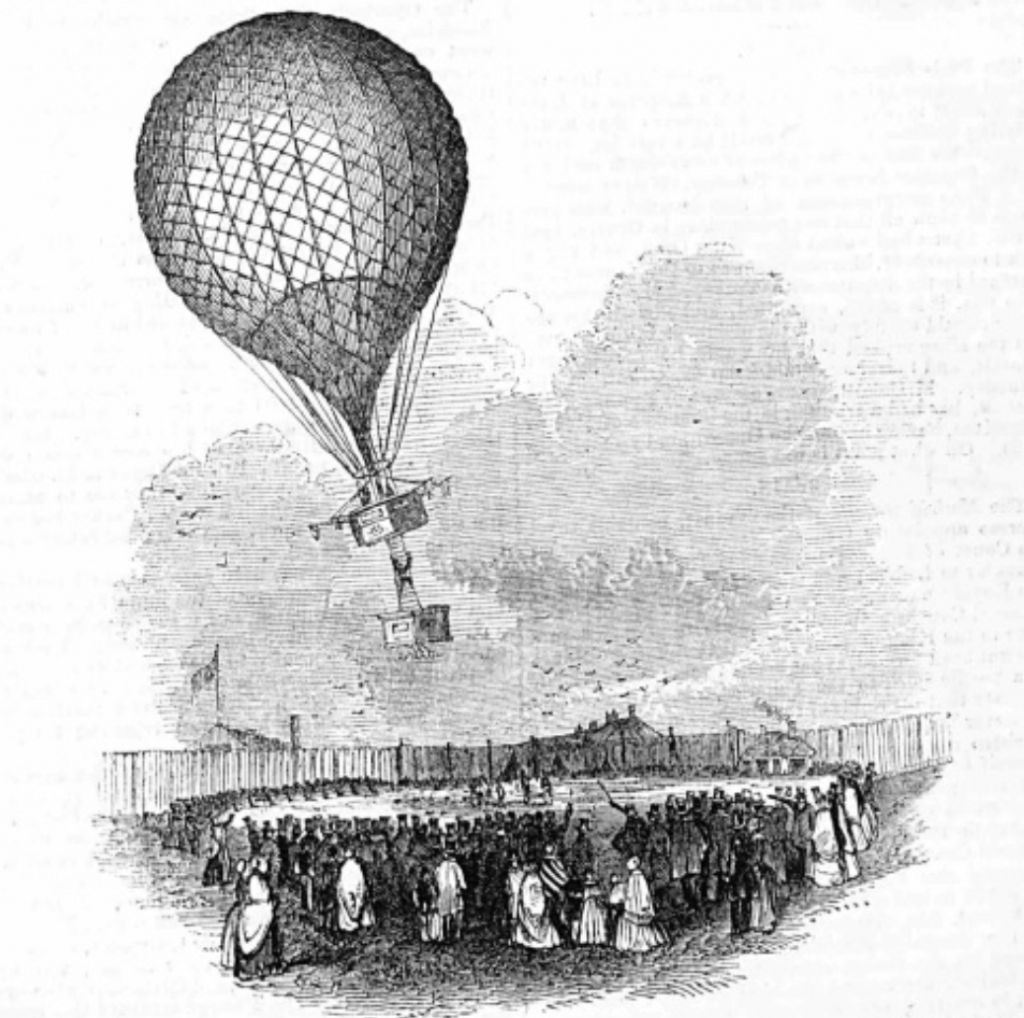
George Gale wrote to the newspapers to give his own account of his successful channel crossing from Shoreham:-
Brighton Gazette, Thursday 18th July, 1850.
THE LATE BALLOON TRIP ACROSS THE CHANNEL
Our last number contained a brief announcement of the night trip of Lieutenant Gale from Shoreham to France in a balloon. Subjoined are fuller details of the voyage, from the pen of the Aeronaut himself:-
“TO THE EDITOR OF THE ERA”
“Sir,- As an account of an extraordinary aeronautic trip across the British Channel from Shoreham to Normandy, in France, may be interesting to your numerous readers, I beg respectfully to furnish you with the following details connected with this, the first successful balloon trip across the widest part of the English Channel:-
“At three o’ clock on Monday morning I was at Hove Gas Works, near Brighton, to superintend the inflation of the Royal Cremorne Balloon. The inflation was completed, the balloon was removed from Hove to the Shoreham and Brighton Railway, where the car was placed upon a truck and drawn to Shoreham, a distance of about 6 miles, and was safely secured in the Swiss Gardens, which were numerously attended by a respectable class of sightseers. At 7 o’clock p.m, I ascended alone; the wind setting seaward (N.N.W), so I declined taking anyone with me, (although my young friend Mr Arthur Goulston, was anxious to share the perils of this most novel trip.)
On rising, the broad expanse of the ocean was immediately presented to my view. In less than two minutes I found myself sailing above the waters, with numerous small craft, their white sails fluttering in the wind, and evidently preparing to run a marine steeple chase after the balloon probably imagining that I descend a short distance from the shore; but I had no such intention. On I went, keeping the shore of England full in view, and after some time I came abreast of Beachy Head, which was the last land I saw. The “shades of evening” began to spread around, and the shore gradually faded from my view. I caused the balloon to descend to within about 200 feet from the water, in order to make my observations as to the rate of speed the balloon was proceeding at.
At this juncture I hailed a schooner and a brig, apparently making up channel. I could hear voices, but could not distinctly hear what they said; however, I felt full confidence in the balloon, and rose to a greater elevation. Having discharged a little more ballast than was absolutely necessary, I found the balloon rapidly ascending. I had previously lost sight of the land; I now lost sight of the water, and the vessels I had seen floating on its surface. Now commenced a series of strange phenomena. The clouds were gathering around me, the stars were brightly breaking forth, and to the northward appeared dull, hazy streaks of light, which gradually diminished until they assumed an appearance similar to the sun, as seen on a winter’s day through a misty fog, and from the same quarter I perceived, at intervals, vivid flashes of sheet lightning.
My altitude now was about 3 miles, the air intensely cold, and as I had risen early in the morning, and had undergone considerable fatigue, I felt a strong inclination to sleep, and found myself dozing over the edge of the car; but I shook off this tendency to drowsiness, and brought the balloon by releasing some gas, to a lower altitude, before doing which, I looked around me on the gathering clouds, and the grandeur of this scene it is impossible to describe, the clouds around, the stars above, appearing larger than they do to beings on the earth. I noticed Ursa Major and the pointers, as also the well-known North Star. Turning my eyes below, was one vast abyss, to which I was gradually descending. I passed through the clouds; the stars were now obscured, and all around was darkness.
I began to hear the rippling of the waves, and saw the white foam of their curling heads. My grapnel presently made a splash in the water, and this reminded me that I must instantly discharge some ballast; I did so, and the balloon sailed majestically along, the grapnel occasionally touching the surface of the water; the length of the cable is 120 feet, so I knew my altitude. Presently I saw a light, which at this period was very cheering, as I was aware that I must be near the land; but I again lost sight of it and this rather dashed my spirits. In a minute or two I again saw the light, and then I discovered that it was a revolving light, and that instead of going towards it I was passing it. I kept the light in view for about an hour and a half, observing the course of the balloon by the trail of the grapnel on the surface of the water. I looked forward through the pitchy darkness endeavouring to descry some object, but all was blank save the light revolving.
Shortly after this I caught the sound of breakers, and in less time than I can describe the grapnel dashed on a rock, giving the balloon a shock, and a second time it struck, again a third, when it seemed to take a fast hold, and the car came to the ground above the surf, having passed over a ledge of rocks without touching the water. I now found myself securely landed under some high and precipitous cliffs, and my first object was to discharge the gas and place my balloon, as well as one pair of hands could do it, in safety. Of course this occupied me a considerable time, and it was 7 o’clock when I started from Shoreham, and 12 when I landed on the shores of France, having traversed over an expanse of ocean of about 100 miles.
Having, as I stated, secured the balloon, the next object was to seek assistance. I gazed above at the cliffs, and on each side of me, doubtful which course to take; I looked East and West, and chose the East, from a peculiar light on the horizon. I must have travelled over a stony beach a distance which I found after to be 6 miles. At length I saw a house at the end of a cliff on a slope on the beach, to which I proceeded; a middle-aged female, in a strange garb, was just opening the door. She appeared much alarmed, and talked rapidly in French. My first request was for water, which she supplied me with. I drank, I think, nearly a quart, and observing this, she asked me if I would take some brandy, which I gladly accepted. She also offered me bread, which I declined, from my inability to swallow it, my throat being so sorely parched with thirst.
While partaking of the brandy the woman gave a signal by shouting, and presently a man with a large moustache came, dressed half in uniform, and demanded my papers. I told him, as well as I could, that I had none, save a copy of the Era newspaper, which I showed him, and that I had descended in a balloon. Upon which he went to the door and called aloud, and five other men came armed. I heard the first man distinctly tell the others that he had arrested a conspirator from Boulogne. It was in vain I expostulated with them, and endeavoured to explain the means and cause of my being there. They unbuttoned my coat, and found I had around my waist the Union Jack of Great Britain, which I had secured to my person in order that it might lead to my recognition in case of accident.
I requested to be taken to some higher authority. After some delay I was marched about 3 miles further in to the town of Creal. I now found that I was in the province of Normandy in France, 14 miles from Dieppe and Treport. The Mayor of Creal perceived that I was very much exhausted from fatigue, and very hospitably set some excellent wine and bread and butter before me. I requested to be taken to the British Conul, which the Mayor, and a Donique, in uniform and armed, sat behind me; the distance I had to go was about 14 miles to Dieppe. We stopped at several houses on the road, where the Mayor explained to the people that I had come in a balloon from England, which they appeared to doubt; however, at every place they gave me wine and offered food.
Arrived in Dieppe, I proceeded to the British Consul, Mr Chapman, who, after an explanation, released me from custody; I then had time to look to the further safety of my balloon, and Mr D.L. Chapman, the brother of the Consul and a respectable shipping agent in Dieppe, took an interest in my case, and furnished me with money and advice. The following morning (Wednesday), at 9 o’clock, I took my departure from Dieppe for England, on board the Magician steamer, of London, belonging to the General Steam Navigation Company. I must now beg to return my thanks to Mr Chapman, the Consul, to his brother, Mr D.L. Chapman, to the Mayor of Creal, and to all parties concerned, for, although being arrested, I know they did not overstep their duty, although it put me to considerable inconvenience.
I am, Sir, your obedient servant,
“George B. Gale, Aeronaut. 24, mansion House Street, Kennington.”
Having heard of the exploits of Eugene Poitevin in France, taking a horse up with him in his balloon to heighten the excitement for the watching crowds, it appears the entertainer in Gale decided to add this trick to his own repertoire, with a sadly unfortunate result, and a lesson that future pilots would learn to their cost, locals will rarely have the necessary knowledge to properly handle these new but potentially dangerous machines:-
The balloon ascent of Poitevin and his horse from the Champ-de-Mars, July 14, 1850, Paris, France, illustration from L’Illustration, Journal Universel…
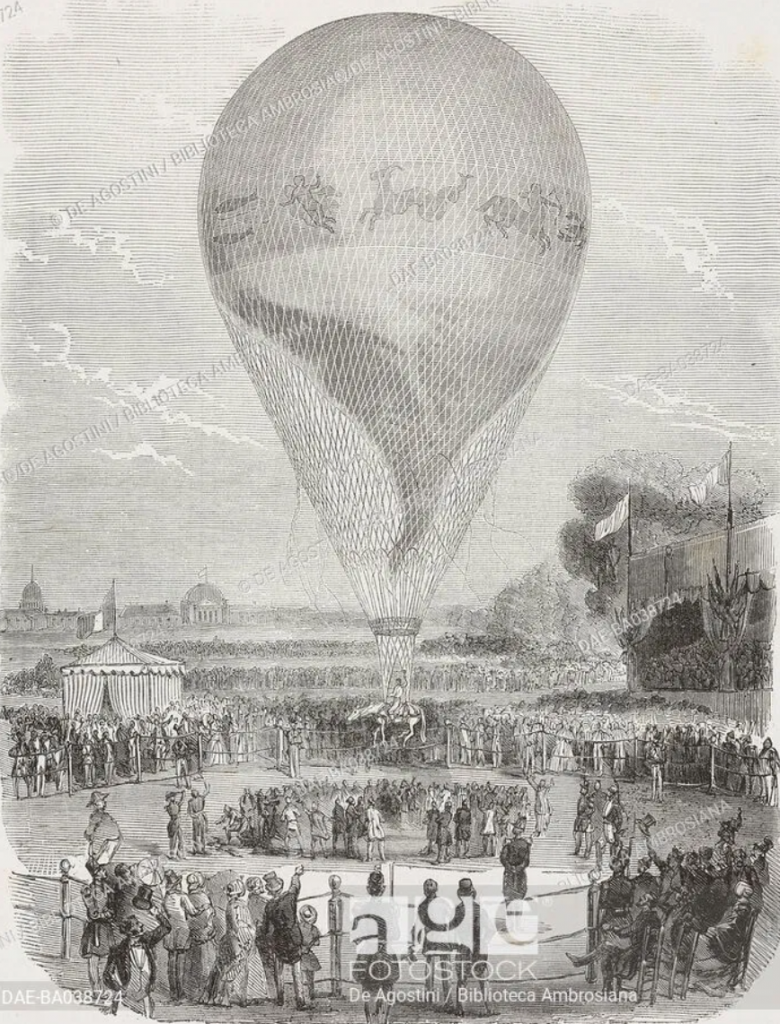
Hertford Mercury and Reformer- Saturday 21 September 1850
Fatal Accident To Lieut. Gale The Aeronaut
‘The Times has the following:- “It is our melancholy province to record the death by accident of Lieut. Gale, the intrepid aeronaut, who, as our readers will remember, crossed the channel some weeks ago in his balloon from the Swiss Gardens, Shoreham. He made several ascents subsequently from the hippodrome at paris, and was led, by the great success which attended M. Poitevin’s exhibitions on horseback, to adopt that novel mode of riding through the air to heighten the excitement of his spectators at Bordeaux.
For this purpose he bought a pony of 2 years old, which had never before been mounted, and in 2 days broke him in to the part he had to perform. So immense a crowd as assembled on Sunday week had never before been seen at Vincennes. At 6 o’clock all Bordeaux was deserted, and several neighbouring villages poured in their contingent of visitors. During the delay in inflating the balloon the pony, gaily saddled and bridled, was paraded round the hippodrome, and caressed by the curious spectators. The little animal suffered himself to be girthed without the least resistance, Lieutenant Gale mounting, with the bridle in one hand, and saluting the crowd with the other, was borne rapidly up into the air. The balloon impelled by a steady wind from the north-west, mounted to a great height, taking the direction of the Lande of Pessac.
Lieutenant Gale had already thrown out his grapnel, which took fast hold in a pine, and the descent seemed on the point of being effected in complete safety, when the peasants who ran to his assistance, after releasing the pony, let go the cords before Lieut. Gale had disengaged himself. The balloon instantly rushing up with immense force, carried with it the unfortunate aeronaut, who clung on to a rope. The branch of the pine to which the grapnel was fastened was torn off by the violence of the shock, and away went the machine mounting to the clouds with the unhappy man. It seems he succeeded in seizing the cord attached to the valve for letting off the gas; for after about a quarter of an hour the balloon was observed to descend, and hopes were entertained that the aeronaut might have escaped the destruction that seemed imminent.
On the next morning, however, the discovery of the balloon half inflated, amidst one of those forests of pines, which stretch over the sandy Lands, left little doubt as to the fatal accident which had befallen its owner. After a long search, a body, identified as Lieut. Gale’s, was found at some distance among the trees. The unfortunate man has left a widow and eight children.’
17 years later, George’s son, Thomas Gale, decided he was going to try a channel crossing to emulate his father’s effort in 1850, departing from the same venue, Swiss Gardens, Shoreham. Explaining the proposed journey and mode of travel, the Cheltenham Chronicle writes:-
Tuesday 8th October 1867
Mr Thomas gale, aeronaut, is preparing to cross the English Channel in a balloon. He has had a balloon and car made specially to meet the contingency of a fall into the sea. He intends to start from Shoreham, on the 10th October, and under the very best circumstances he must travel 84 miles before reaching France. If the wind should be E.N.E, or E.S.E, Mr Gale considers that it would be absolutely necessary to lower the balloon in order that the car may descend into the water, and prevent the balloon and car being carried into the Atlantic ocean.
The very nature of balloon flying, and its reliance on the natural elements, not least the direction of the wind, meant things didn’t always go according to plan, and such was the case with Thomas Gale’s attempt to cross the English Channel, but he had promised the spectators they would see a flight, and the Sussex Advertiser covered the event in its issue dated:-
Saturday 19 October 1867
The Balloon Ascent From The Swiss Gardens-
Mr Gale, aeronaut, kept his word with the public, that he would make his ascent on Wednesday, under any circumstances; but , owing to the very unfavourable state of the weather, a heavy shower of rain descending at the time, condensing the gas very rapidly, he did not proceed more than a mile and a half, in an easterly direction, and alighted safely in a sheep field at Kingston.
Thomas Gale went to Australia soon after, where he made some famous balloon ascents over Sydney in 1870/71.
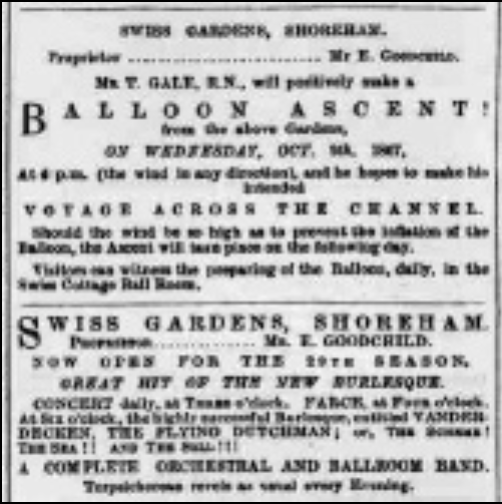
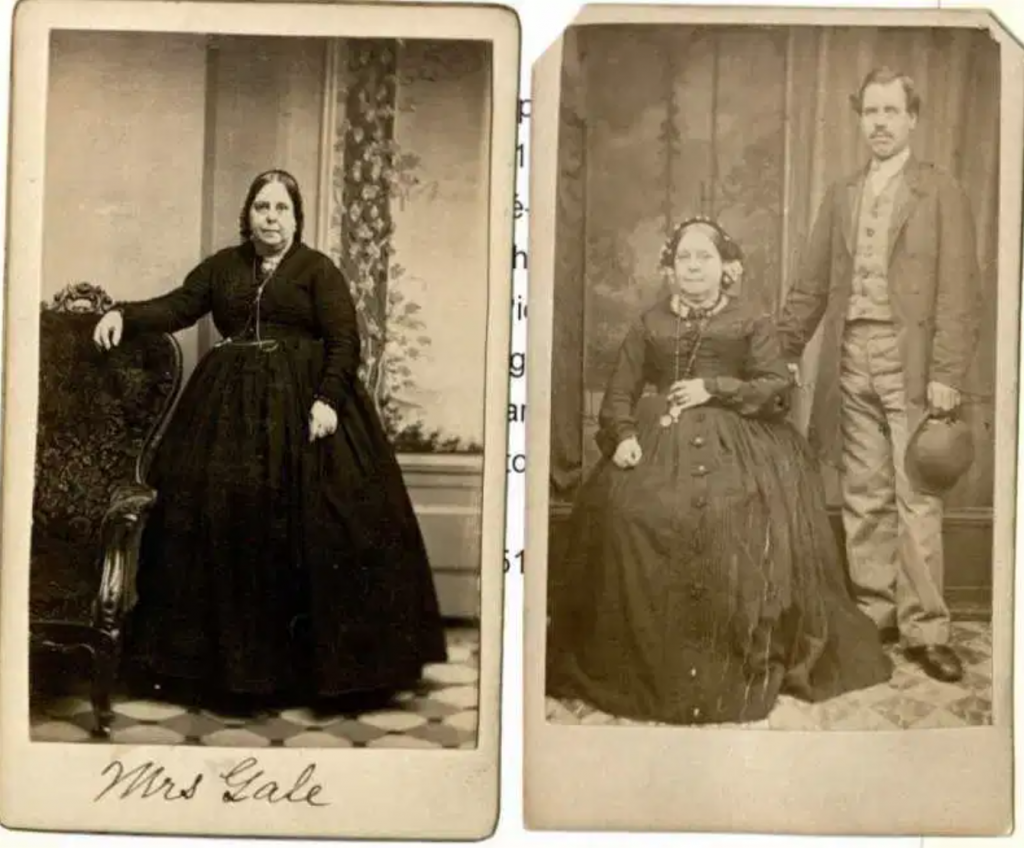
Thursday 5th July 1877, Captain Youens made an ascent from Shoreham’s Swiss Gardens with a crowd of 2000 in attendance. Excerpts which follow are from the Brighton Herald of Saturday 7th July 1877
THE GRAND BALLOON ASCENT AT THE SWISS GARDENS
Thursday last must be registered as a red letter day in the annals of the Swiss gardens. The grand balloon ascent, by Captain Youens, as arranged for on that day by the spirited proprietors, the Messrs. Mellison, proved to be a success in every respect.
Further on it states:-
The 2000 odd spectators assembled were treated to a sight to be remembered, and which, there is no doubt, will be repeated at an early date.
Describing the scene that greeted the arriving crowds, they report:-
The ascent took place a little later than was at first arranged; but the preliminaries afforded such an interesting and novel spectacle that this was little thought of, and therefore, -as it kept the curiosity of the spectators completely occupied,- maybe regarded as an advantage! The ascent was to be from the eastern lawn; and entering the Gardens at about 6 0’clock, the visitor, on reaching the lawn, saw in the centre of a roped enclosure a huge excrescence, shaped like a “shepherd’s stone”, or half an orange- of brownish hue, with darker bands running from the base to the apex, and on the sides of which were painted in large letters “Champion”. On closed inspection, this excrescence, – which proved to be the balloon in course of inflation,- was seen to be entirely quilted by cords, in diamonds, while round it, on the ground, attached to these cords, were ranged some 40 or 50 bags, containing wet sand, and each weighing about 20 lbs., for the purpose of steadying it and holding it down during inflation.
After a traumatic journey, which nearly saw them taken by the air currents, unwillingly out to sea, Captain Youens and his reporter passenger, Mr Wood, managed to bring themselves down over Poynings. The Brighton Herald article describes their eventual descent:-
In 17 minutes the aeronauts found themselves over Poynings, and determined there to return to mother earth, the weather being now very threatening. The grappling irons were thrown out, which, laying hold on the ground, somewhat checked the speed of the balloon. A hedge was next laid hold of by the irons, but for a moment; part of the thicket was torn away, and, the car sustaining an unexpected jerk, Mr Wood was well-nigh pitched out, and Captain Youens lost a valuable aneroid barometer, which, it is hoped, will be returned to the owner. Immediately after the car lodged in another hedge, and fortunately, several persons being at hand, every assistance was afforded. The voyagers learned that they were upon the land of Mr Martin Robinson, of Seddlescombe, who, after the gas in the balloon had been allowed to escape and it had been packed in the car, entertained the travellers most hospitably. They had been in mid air about 17 minutes, and during that time must have covered 17 miles- a journey whose termination, Captain Youens said, was among the worst without accident which he had yet experienced.
Moving on to the 20th century, there was a flutter of interest when a certain famous explorer, Captain Scott, landed in a balloon on the Southdown Golf Club on the Sussex Downs at Shoreham. The Brighton Gazette had it covered:-
Saturday 3rd July 1909
Balloon Descents
About 6 o’clock on Thursday evening golfers on the links of the Southdown Golf Club at Shoreham-by-Sea were surprised by a balloon which descended on the course. It turned out to be a pleasure party from the Crystal Palace, including Professor Huntingdon, Captain Scott of the “Discovery”, Dr Nathan, and Mr. Nathan. They had ascended from the Crystal Palace at half-past 3 that afternoon, and after a fair voyage put into “port” at Shoreham without mishap. The balloon was quickly packed up, and the party left Shoreham by the 7.16p.m. train.
Andy Ramus 2021
For the additional article chapters follow the links:

